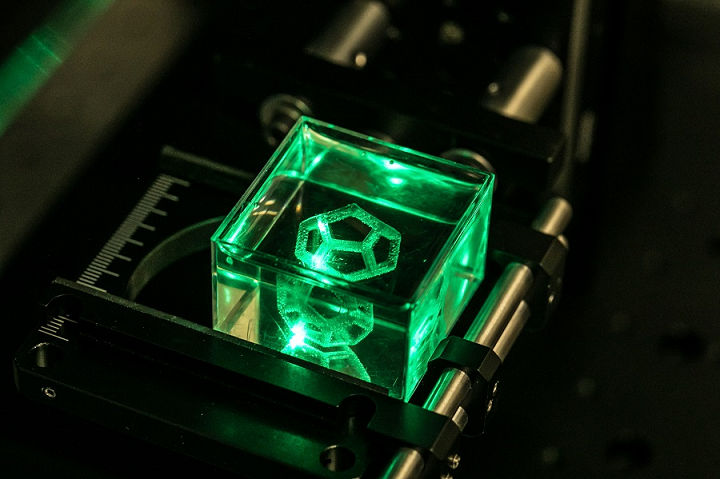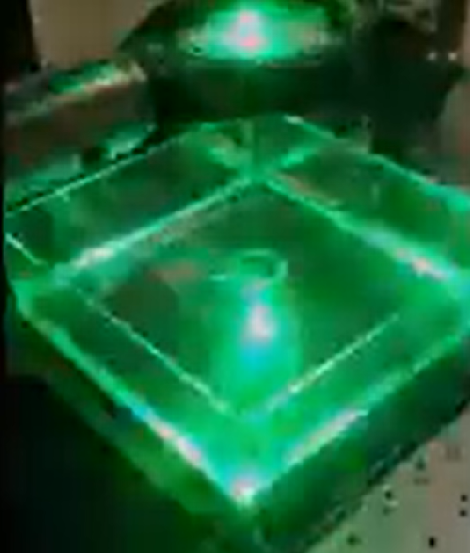3D printing glass is a pretty tricky feat, mainly because it’s hard to maintain the material’s mechanical properties at its very high melting point. But a trio of researchers from France published a research paper in The Optical Society (OSA) journal Optics Letters about their work in creating a new laser-based method of printing intricate glass parts. The team used their newly developed technique, which is based on multiphoton polymerization, to print detailed glass objects without relying on the normal layer-by-layer fabrication of 3D printing, and believe that their method could possibly be used to 3D print complex optics for laser-based imaging and vision applications in the future.
“Glass is one of the primary materials used to make optics. Our work represents a first step toward developing a process that could one day allow scientists to 3D print the optical components they need,” said research team leader Laurent Gallais from The Fresnel Institute and Ecole Centrale Marseille.

Researchers have developed a new laser-based process for 3D printing intricate parts made of glass. It uses multiphoton polymerization to create an object directly in a 3D volume.
Layer-by-layer 3D printing is not ideal for fabricating objects out of glass. With viscous resins, it’s tough to achieve layers that have consistent thicknesses, and supports are often needed for complex parts, which need to be removed at the end of the process…slowing the whole thing down even more.
“Most 3D printing processes build up an object layer by layer. Our new process avoids the limitations of these processes by using a laser beam to transform — or polymerize — a liquid precursor into solid glass,” Gallais explained.
With multiphoton polymerization, the process that links liquid monomer molecules into a solid polymer (aka polymerization) occurs at the exact laser focal point, which makes it possible to 3D print small, accurate parts that measure from just a few microns up to tens of centimeters at a great resolution. But, don’t get me wrong, it’s still a little complicated.
When you’re using this method to 3D print with glass, the specific material needs to be transparent at the laser’s wavelength during the initial liquid phase, and once it’s fully polymerized, as well. Additionally, it needs to absorb the light from the laser at half its wavelength in order to initiate multiphoton polymerization. So, the team used a mixture with a photochemical initiator to absorb the light, plenty of silica nanoparticles, and a resin to achieve this.
The abstract of the research paper states, “We introduce a laser-based process relying on multiphoton-induced polymerization to produce complex three-dimensional (3D) glass parts. A focused, intense laser beam is used to polymerize a transparent resin, loaded with additives and silica nanoparticles, at the wavelength of the laser beam through nonlinear absorption processes. The object is created directly in the volume, overcoming the limitation of the layer-by-layer process. The process enables the production of silica parts with consecutive debinding and sintering processes. With bulk silica density and a resolution that depends on the laser spot size, 3D objects of centimetric dimensions are obtained.”

Screenshot from video, which shows a laser being used to polymerize a liquid containing silica nanoparticles to create a miniature glass bicycle.
The research team’s highly viscous mixture, which not only works with the laser, also makes it possible to 3D print a part without deformation issues, or the use of supports.
“Critical to the technique were high power ultrashort lasers based on Strickland and Mourou’s chirped pulse amplification technology recognized with a Nobel prize in 2018. Only intense and very short pulses will create non-linear photo polymerization with high precision and no thermal effects,” Gallais said.
Once they affirmed that they could use their silica nanoparticle mixture to make a solid object, the researchers 3D printed several complex glass objects without any cracks or pores, like a tiny Eiffel Tower and bicycle. Additionally, they were able to apply another process to their method that can transform the polymerized parts into glass ones.

The new approach can be used to 3D print a variety of complex objects such as the Eiffel Tower and the bicycle shown here.
Future work includes lowering the cost by using a less expensive laser, which will also help make the method more practical.
Gallais said, “Our approach could potentially be used to produce almost any type of 3D glass object. For example, we are exploring the possibility of producing glass parts that could be used on luxury watches or perfume bottles.”
The team also wants to improve the surface quality of glass parts 3D printed with its technique, which will help make the parts less rough.
(Source: Mirage News / Images: Laurent Gallais, The Fresnel Institute and Ecole Centrale Marseille)
Subscribe to Our Email Newsletter
Stay up-to-date on all the latest news from the 3D printing industry and receive information and offers from third party vendors.
You May Also Like
New Report: Semiconductor Industry to See $1.4B in 3D Printing Revenues by 2032
“The semiconductor sector has become the most strategically significant area of global industry.” Truer words are hard to come by when it comes to the modern world, and they are...
Will Photonic-Crystal Lasers Revolutionize 3D Printing?
Powder bed fusion (PBF) for metals and polymers predominantly utilizes lasers as the primary heat source. Some directed energy deposition (DED) technologies also employ lasers, while various vat polymerization methods...
3D Printing Unpeeled: Orbex Investment, IndoMIM and HP, Ultrasonic Waves
INDO-MIM has bought three HP Metal Jet S100 printers, operating two in India and one in Texas. This is a win for HP because the company has deep experience in...
3D Printing Webinar and Event Roundup: April 21, 2024
It’s another busy week of webinars and events, starting with Hannover Messe in Germany and continuing with Metalcasting Congress, Chinaplas, TechBlick’s Innovation Festival, and more. Stratasys continues its advanced training...































